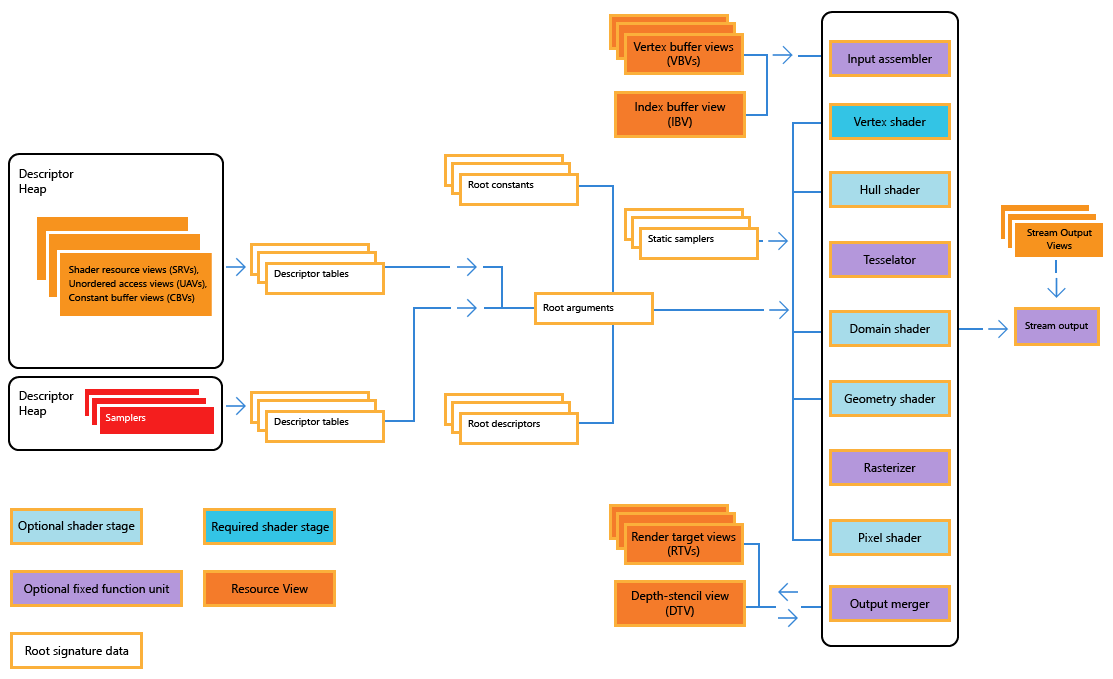Intro to DirectX 12 Pipeline

DirectX 12 organizes graphics rendering into pipelines.
Components of DirectX 12 Pipeline:
-
Command Lists and Command Allocators: Command lists contain the rendering commands (draw calls, resource bindings, compute dispatches) that GPU will execute. Command allocators manage the memory for these command lists.
-
Pipeline State Objects (PSOs): PSOs define the state and configuration of the GPU pipeline. This includes input assembler configuration (vertex buffers, index buffers), shader configuration (vertex, hull, domain, geometry, pixel shaders), rasterizer state, depth-stencil state (depth and stencil testing), blend state (output merging), and other fixed function states.
-
Root Signatures: Root signatures describe which resources (constant buffers, textures, samplers) are accessible to shaders. They define the interface between shaders and the application.
-
Descriptor Heaps and Tables: Descriptor heaps and tables manage resources like textures and buffers. Descriptor heaps store resource descriptors, and descriptor tables contain pointers to these descriptors, which shaders use to access resources.
-
Resource Barriers: DirectX 12 introduces explicit resource barriers to specify transitions between resource states (render target to shader resource) and synchronization between GPU and CPU operations.
Execution Flow:
Let’s break down the steps:
- Initialization:
Create the device, command queue, swap chain, and other necessary objects.
- Create the Device and Command Queue:
1 2 3 4 5 6 7 8
ID3D12Device* device; D3D12CreateDevice(nullptr, D3D_FEATURE_LEVEL_11_0, IID_PPV_ARGS(&device)); ID3D12CommandQueue* commandQueue; D3D12_COMMAND_QUEUE_DESC queueDesc = {}; queueDesc.Type = D3D12_COMMAND_LIST_TYPE_DIRECT; queueDesc.Flags = D3D12_COMMAND_QUEUE_FLAG_NONE; device->CreateCommandQueue(&queueDesc, IID_PPV_ARGS(&commandQueue));
- Create the Swap Chain:
1 2 3 4 5 6 7 8 9 10 11 12 13 14
IDXGISwapChain3* swapChain; DXGI_SWAP_CHAIN_DESC swapChainDesc = {}; swapChainDesc.BufferCount = 2; swapChainDesc.BufferDesc.Width = width; swapChainDesc.BufferDesc.Height = height; swapChainDesc.BufferDesc.Format = DXGI_FORMAT_R8G8B8A8_UNORM; swapChainDesc.BufferUsage = DXGI_USAGE_RENDER_TARGET_OUTPUT; swapChainDesc.SwapEffect = DXGI_SWAP_EFFECT_FLIP_DISCARD; swapChainDesc.OutputWindow = hwnd; swapChainDesc.SampleDesc.Count = 1; swapChainDesc.Windowed = TRUE; IDXGIFactory4* factory; CreateDXGIFactory1(IID_PPV_ARGS(&factory)); factory->CreateSwapChain(commandQueue, &swapChainDesc, (IDXGISwapChain**)&swapChain);
- Create the Device and Command Queue:
- Resource Setup:
Create buffers, textures, and views in GPU memory.
- Create Vertex Buffer:
1 2 3 4 5 6 7 8 9 10 11 12 13 14 15 16 17 18
struct Vertex { float position[3]; float color[3]; }; Vertex triangleVertices[] = { { { 0.0f, 0.5f, 0.0f }, { 1.0f, 0.0f, 0.0f } }, { { 0.5f, -0.5f, 0.0f }, { 0.0f, 1.0f, 0.0f } }, { {-0.5f, -0.5f, 0.0f }, { 0.0f, 0.0f, 1.0f } } }; ID3D12Resource* vertexBuffer; CD3DX12_HEAP_PROPERTIES heapProps(D3D12_HEAP_TYPE_UPLOAD); CD3DX12_RESOURCE_DESC bufferDesc = CD3DX12_RESOURCE_DESC::Buffer(sizeof(triangleVertices)); device->CreateCommittedResource(&heapProps, D3D12_HEAP_FLAG_NONE, &bufferDesc, D3D12_RESOURCE_STATE_GENERIC_READ, nullptr, IID_PPV_ARGS(&vertexBuffer)); void* pVertexDataBegin; CD3DX12_RANGE readRange(0, 0); vertexBuffer->Map(0, &readRange, &pVertexDataBegin); memcpy(pVertexDataBegin, triangleVertices, sizeof(triangleVertices)); vertexBuffer->Unmap(0, nullptr);
- Create Vertex Buffer View:
1 2 3 4
D3D12_VERTEX_BUFFER_VIEW vertexBufferView = {}; vertexBufferView.BufferLocation = vertexBuffer->GetGPUVirtualAddress(); vertexBufferView.StrideInBytes = sizeof(Vertex); vertexBufferView.SizeInBytes = sizeof(triangleVertices);
- Create Vertex Buffer:
- Pipeline Setup:
Define and compile shaders (HLSL), create PSOs, define root signatures, and set up descriptor heaps.
- Define and Compile Shaders:
1 2 3 4 5 6 7 8 9 10 11 12 13 14 15 16 17 18 19 20 21 22 23 24
// Vertex Shader (HLSL) struct VSInput { float3 position : POSITION; float3 color : COLOR; }; struct PSInput { float4 position : SV_POSITION; float3 color : COLOR; }; PSInput VSMain(VSInput input) { PSInput output; output.position = float4(input.position, 1.0f); output.color = input.color; return output; } // Pixel Shader (HLSL) struct PSInput { float4 position : SV_POSITION; float3 color : COLOR; }; float4 PSMain(PSInput input) : SV_TARGET { return float4(input.color, 1.0f); }
- Create Root Signature:
1 2 3 4 5 6 7 8 9 10 11 12
D3D12_ROOT_SIGNATURE_DESC rootSignatureDesc; rootSignatureDesc.NumParameters = 0; rootSignatureDesc.pParameters = nullptr; rootSignatureDesc.NumStaticSamplers = 0; rootSignatureDesc.pStaticSamplers = nullptr; rootSignatureDesc.Flags = D3D12_ROOT_SIGNATURE_FLAG_ALLOW_INPUT_ASSEMBLER_INPUT_LAYOUT; ID3DBlob* signature; ID3DBlob* error; D3D12SerializeRootSignature(&rootSignatureDesc, D3D_ROOT_SIGNATURE_VERSION_1, &signature, &error); ID3D12RootSignature* rootSignature; device->CreateRootSignature(0, signature->GetBufferPointer(), signature->GetBufferSize(), IID_PPV_ARGS(&rootSignature));
- Create Pipeline State Object (PSO):
1 2 3 4 5 6 7 8 9 10 11 12 13 14 15 16
D3D12_GRAPHICS_PIPELINE_STATE_DESC psoDesc = {}; psoDesc.InputLayout = { inputLayout, _countof(inputLayout) }; psoDesc.pRootSignature = rootSignature; psoDesc.VS = { vertexShader->GetBufferPointer(), vertexShader->GetBufferSize() }; psoDesc.PS = { pixelShader->GetBufferPointer(), pixelShader->GetBufferSize() }; psoDesc.RasterizerState = CD3DX12_RASTERIZER_DESC(D3D12_DEFAULT); psoDesc.BlendState = CD3DX12_BLEND_DESC(D3D12_DEFAULT); psoDesc.DepthStencilState.DepthEnable = FALSE; psoDesc.DepthStencilState.StencilEnable = FALSE; psoDesc.SampleMask = UINT_MAX; psoDesc.PrimitiveTopologyType = D3D12_PRIMITIVE_TOPOLOGY_TYPE_TRIANGLE; psoDesc.NumRenderTargets = 1; psoDesc.RTVFormats[0] = DXGI_FORMAT_R8G8B8A8_UNORM; psoDesc.SampleDesc.Count = 1; ID3D12PipelineState* pipelineState; device->CreateGraphicsPipelineState(&psoDesc, IID_PPV_ARGS(&pipelineState));
- Define and Compile Shaders:
- Rendering Loop:
Begin a command list, set the pipeline state, bind resources (through descriptors), issue draw calls or dispatch compute shaders, and then execute the command list on the GPU.
- Begin Command List:
1 2 3 4 5
ID3D12CommandAllocator* commandAllocator; device->CreateCommandAllocator(D3D12_COMMAND_LIST_TYPE_DIRECT, IID_PPV_ARGS(&commandAllocator)); ID3D12GraphicsCommandList* commandList; device->CreateCommandList(0, D3D12_COMMAND_LIST_TYPE_DIRECT, commandAllocator, pipelineState, IID_PPV_ARGS(&commandList)); commandList->Close();
- Record Commands:
1 2 3 4 5 6 7 8 9 10 11 12 13 14
commandAllocator->Reset(); commandList->Reset(commandAllocator, pipelineState); commandList->SetGraphicsRootSignature(rootSignature); commandList->RSSetViewports(1, &viewport); commandList->RSSetScissorRects(1, &scissorRect); commandList->ResourceBarrier(1, &CD3DX12_RESOURCE_BARRIER::Transition(renderTarget, D3D12_RESOURCE_STATE_PRESENT, D3D12_RESOURCE_STATE_RENDER_TARGET)); commandList->OMSetRenderTargets(1, &rtvHandle, FALSE, nullptr); const float clearColor[] = { 0.0f, 0.2f, 0.4f, 1.0f }; commandList->ClearRenderTargetView(rtvHandle, clearColor, 0, nullptr); commandList->IASetPrimitiveTopology(D3D_PRIMITIVE_TOPOLOGY_TRIANGLELIST); commandList->IASetVertexBuffers(0, 1, &vertexBufferView); commandList->DrawInstanced(3, 1, 0, 0); commandList->ResourceBarrier(1, &CD3DX12_RESOURCE_BARRIER::Transition(renderTarget, D3D12_RESOURCE_STATE_RENDER_TARGET, D3D12_RESOURCE_STATE_PRESENT)); commandList->Close();
- Execute Command List:
1 2 3
ID3D12CommandList* ppCommandLists[] = { commandList }; commandQueue->ExecuteCommandLists(_countof(ppCommandLists), ppCommandLists); swapChain->Present(1, 0);
- Begin Command List:
- Resource Management and Synchronization:
Use resource barriers to synchronize access to resources between different stages of the pipeline and between GPU and CPU.
- Use Fences for Synchronization:
1 2 3 4 5 6 7 8 9 10 11 12
ID3D12Fence* fence; device->CreateFence(0, D3D12_FENCE_FLAG_NONE, IID_PPV_ARGS(&fence)); HANDLE fenceEvent = CreateEvent(nullptr, FALSE, FALSE, nullptr); UINT64 fenceValue = 1; // Signal and wait for the fence commandQueue->Signal(fence, fenceValue); if (fence->GetCompletedValue() < fenceValue) { fence->SetEventOnCompletion(fenceValue, fenceEvent); WaitForSingleObject(fenceEvent, INFINITE); } fenceValue++;
- Use Fences for Synchronization:
- Cleanup:
Release resources and clean up allocated memory when rendering is complete.
- Release Resources:
1 2 3 4 5 6 7 8 9 10
vertexBuffer->Release(); pipelineState->Release(); rootSignature->Release(); commandList->Release(); commandAllocator->Release(); commandQueue->Release(); swapChain->Release(); device->Release();
- Release Resources:
Summary:
- Initialization: Set up the device, command queue, and swap chain.
- Resource Setup: Create and upload vertex buffer data.
- Pipeline Setup: Define shaders, create root signature and PSO.
- Rendering Loop: Record and execute command lists for rendering the triangle.
- Resource Management: Use fences for synchronization.
- Cleanup: Release resources after rendering.